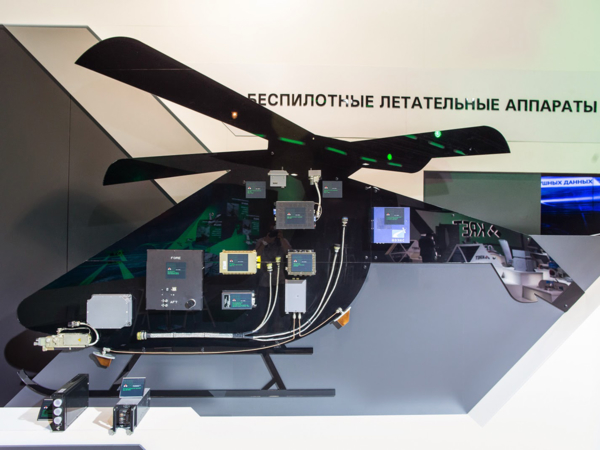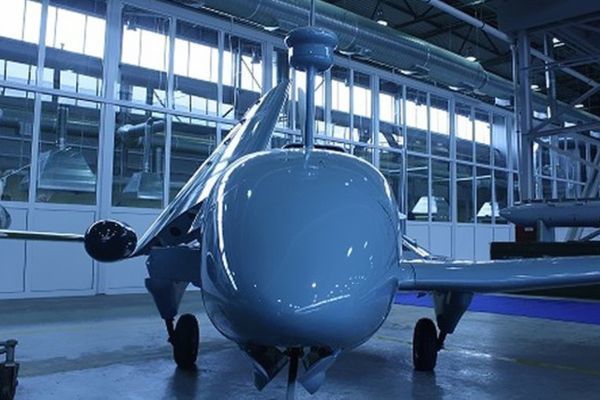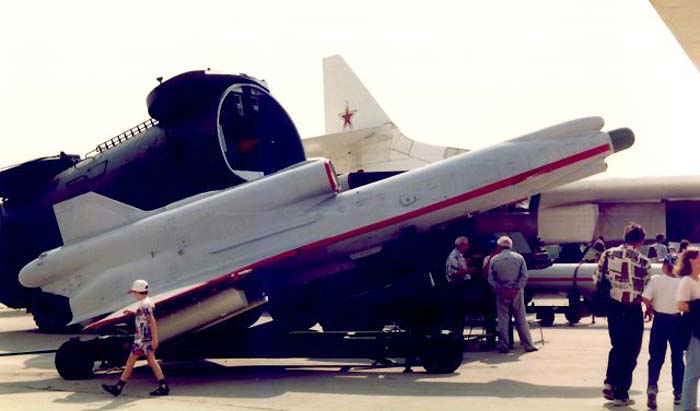Vladimir Mikheev: We are on the threshold of a new era of unmanned aircraftFirst Counsellor Deputy KRET spoke about the developments in the field of UAVs Today KRET - one of the leading domestic developers of unmanned aerial vehicles. On the latest developments in this field and technologies of the future, he told the adviser to first deputy general director of the concern Vladimir Mikheev.- How would you define a strategy KRET in the field of unmanned aerial vehicles? On what this market niche group claims?
Today KRET - one of the leading domestic developers of unmanned aerial vehicles. On the latest developments in this field and technologies of the future, he told the adviser to first deputy general director of the concern Vladimir Mikheev.- How would you define a strategy KRET in the field of unmanned aerial vehicles? On what this market niche group claims?- KRET is Russia's largest center for the development and production of avionics systems and electronic warfare systems for aircraft and helicopters. This role group to continue in terms of the evolution of aviation in the direction of greater use of unmanned systems.
We have long paid attention to the trend of output systems with unmanned aerial vehicles from the periphery to the core of his track and have taken a series of measures, especially in the field of conducting R & D and production base preparation. Through these measures, we can now say with confidence that in Russia created a world-class avionics for unmanned aerial vehicles of all classes and types. All sets of equipment carried on the principle of an open architecture that allows you to create different configurations of airborne equipment in a modular fashion, taking into account the tasks and specialization of UAVs.
Our solutions can be installed on Russian and foreign devices, which opens up for us a rich global market of combat and civil unmanned systems, which is now experiencing rapid growth. Its volume is already of the order of $ 7 billion, and by 2020, even by the most conservative forecasts of industry experts, will exceed $ 10 billion. OEE is from 30 to 70% of the drone, depending on the type and specification. These figures give a clear idea of the importance and economic prospects of our work.
- What is the feature of the work on the equipment for UAV? How does it differ from the systems for manned aircraft?
- The main difference is reflected in the very name of these systems - they are unmanned, that is, they have no rights, which at the present stage of technological development becomes the weakest link, not only in the management of aircraft equipment, but also at the level of technical approaches to its implementation.
If we remove the person immediately becomes possible to significantly improve flight control and navigation systems, which are responsible for control of the aircraft. In addition, when creating a drone is not a task to protect the pilot from overload, the UAV can fly through the paths with such speed that allow the laws of aerodynamics and the characteristics of its power plant. A person can lose consciousness already on overload in the 3-5 g, prepared by the pilot can withstand short-term overload up to 6-7 g, and the UAV can be flown with overloads of up to 20 g and more.
All of this suggests that the evolution of UAVs will go quite different and depend on several other technological solutions. For example, in an aircraft the person is included in management. From the moment of receipt of the information before making a decision, which is realized with the rotary passes some time. This time is sufficiently large. Until he makes a decision, the aircraft can overcome several tens or even hundreds of meters. In the case of the UAV more and more such decisions will be made automatically during the numbering in milliseconds, and depend on the quality and speed of data collection and flight information, the computer which processes it.
The lack of cockpit allows the pilot not to take into account when creating a range of UAVs restrictions on heat load and protect people from harmful microwave radiation. UAVs can fly at hypersonic speeds by going to the plasma, and the need to cool a heat-sensitive equipment, but even she can tolerate much more heat than the human body.
The flight can take place not only at high speeds, but other ballistic trajectories. For example, in the near space, where there are hard X-rays.
Such nuances are many. Some of them we are not going to disclose. But today with certainty we can say that we are on the threshold of a new era of unmanned aircraft.
- Which problem will solve KRET equipment installed for military UAVs?- Despite all the unique features of UAVs primarily intended to replace the manned aircraft, and they have to do its work more effectively with the military and, more importantly, from an economic point of view. For our country, in this sense, primary interest is the work in remote areas, especially in the Far North. To cover the vast expanse of the northern border, we just needed a large UAV flight duration, which are able to conduct a comprehensive exploration of ground facilities and airspace, including video surveillance, radar and electronic reconnaissance, search-infrared, ultraviolet and laser radiation. In this role, UAVs will be very effective. Equipment for the solution of these problems have already been created, he needs support.
- Is it true that research in nanophotonics who leads KRET, will eventually create radars, suitable for installation in medium-sized drones and not inferior to the capabilities of the onboard radar of modern fighters?- It really is. One of the main areas on which we are working today - is the development of so-called radio-optical phased array antenna (ROFAR). It will be useful primarily for the UAV. The elements of antenna systems based on photonic crystals, which will be ROFAR, you can cover a large surface area of the drone. Accordingly, these surfaces can radiate more power at high efficiency.
ROFAR possesses another essential for UAV property - it can be a long time in the air without maintenance. In this sense, the autonomy of a superior autonomy modern radar drones - it can work non-stop for several days.
- You said that KRET adapts to all its UAV competencies, and it is primarily the creation of EW. How do you assess the prospects of unmanned technologies from this perspective?- If we are talking about UAVs, do not forget that this is primarily an aircraft, and according to all military tactical and technical requirements it shall be equipped with airborne defense. We have today made proposals for the installation of protection on drones heavy, medium, and even a touch of class. This is necessary, because, regardless of the purpose of UAVs is the object of priority destruction. For the opponent it is important to neutralize as quickly as possible, and for us it is important to maintain its function for as long period of time. This will primarily depend on the effectiveness of airborne electronic warfare.
Aircraft medium and heavy classes can be used as jammers. This is quite promising direction of development. After all, the UAV can be in close proximity to a particular area of hostilities, without risking the life of the crew. He will be able to conduct electronic warfare as close to the enemy's radio-electronic means.
UAV as the jammer is also a purely economic advantage over manned vehicles. EW Group funds have large areas of antenna systems and high power radiation, and this in the presence of a person on board necessitating the use of special protection measures. Man is to be protected from the microwave radiation, and this implies additional costs for the design and construction of aircraft and helicopters. On bespilotnike all to anything. It is "inhumane" apparatus, there is simply no one to protect.
- Participates whether KRET in creating solutions to counter system to combat UAVs, which are now being actively developed in the world?- All countries of the world understand the danger of UAV systems and are working on means to combat them. We, like other global companies working to create similar solutions and were able to go far enough in this direction. Both in Russia and abroad, work on the creation of funds to counter drones and protection against such effects go hand in hand. I will not disclose the details of this work, but I can say that we have carried out a series of scientific studies on the detection of drones and the corresponding effect on them.
This can not only battle enemy UAV. In peacetime this problem is perhaps more important. With the proliferation and improvement of domestic drones them necessary to ensure the protection of protected objects, such as, for example, airports, power generation facilities, hazardous production. Furthermore, they may be used by terrorists. Shoot down all suspicious drones over densely populated areas - it is certainly not out. It is much more justified in terms of both the economy and the sense of neutralization using electronic defeat. In essence, this means the same REB, only sharpened by a special software and hardware technical impact on the drones. If we disable his communications, navigation and data transmission on board, caught his control, he quietly and imperceptibly longer pose any whatsoever danger.
In the military sphere, we're not just talking about the defense of the object, but also about finding a large area devices of the enemy, who are doing everything to hide from us as long as possible. Here, on the first place electronic reconnaissance. Any drone carries a large number of different control systems, communications, navigation and location, and accordingly it is celebrated on the radio. Here on these grounds, their quantitative and qualitative characteristics we are far enough away that we can locate the device, its type and other important information. On this basis, we are preparing some impact.
Works are carried out immediately in all directions. At some point, we will post them and will share them with the world community.
- Do KRET has extensive experience in creating helmet-mounted target designation systems and control systems for manned helicopters and planes. Have you considered the possibility of adapting them to control the UAV?- We are working in this direction. At one of the companies developed a sufficiently large series of types of equipment, including a ground control drones. In essence, this is the same multi-pilot helmet, only to realize on the desktop UAV operator.
For convenience, the screen is made not in the form of a helmet, and a conventional digital multifunction display, which can display much more information - multispectral technical "sight" of the device, the substrate or the geographical map, for example, a task which the machine performs. Thus, using a real pen or joystick that can be remotely controlled drones, sitting in a fairly safe environment. According to well-protected channels all this information will be transmitted to the board, and the board will conduct reconnaissance, to perform any additional actions in standalone mode, and the mode of external target designation.
http://rostec.ru/news/4517331














